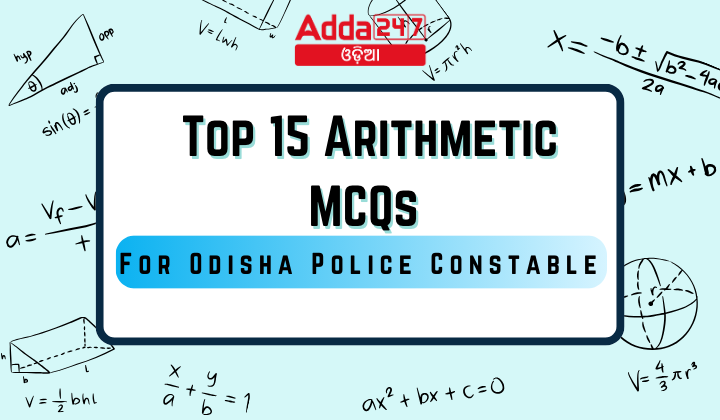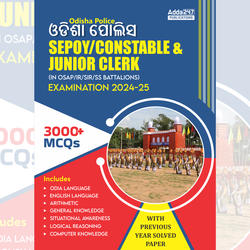The “Top 15 Arithmetic MCQs for Odisha Police Constable Exam” covers essential mathematical concepts critical for competitive exam preparation. This set includes questions from various topics such as Pipe & Cistern, Number System, Time & Work, Simple Interest (SI) & Compound Interest (CI), Calendar Days Calculation, Profit & Loss, Simplification, Probability, Time & Distance, Mensuration, LCM & HCF, and Boat & Stream. Each question is crafted to challenge candidates’ problem-solving skills and enhance their arithmetic proficiency. These MCQs offer a comprehensive approach to mastering key topics, providing step-by-step solutions and detailed Sols to aid in exam readiness.
Top 15 Arithmetic MCQs For Odisha Police Constable 02 November 2024
1. A shopkeeper buys a pen for $25 and sells it for $30. What is the profit percentage?
(a) 10%
(b) 15%
(c) 20%
(d) 25%
Ans: (c) 20%
Sol: Profit = Selling Price – Cost Price = $30 – $25 = $5.
Profit Percentage = (Profit / Cost Price) × 100 = (5 / 25) × 100 = 20%.
2. The ratio of ages of two brothers is 3:4. If the elder brother is 12 years older than the younger, what is the younger brother’s age?
(a) 24 years
(b) 36 years
(c) 16 years
(d) 12 years
Ans: (b) 36 years
Sol: Let the ages be 3x and 4x.
4x – 3x = 12 ⟹ x = 12.
So, younger brother’s age = 3x = 3 × 12 = 36 years.
3. If a number is divided by 8, it gives a remainder of 5. What will be the remainder when twice the number is divided by 8?
(a) 3
(b) 4
(c) 6
(d) 2
Ans:(d) 2
Sol: Let the number be n=8k+5n = 8k + 5n=8k+5. Then, twice the number is 2n=16k+10
Dividing it by 8 gives a remainder of 2
4. What is the compound interest on $5000 at 10% per annum for 2 years?
(a) $1000
(b) $1050
(c) $1100
(d) $1150
Ans: (b) $1050
Sol: Compound Interest = P(1+r/100)^n−P
= 5000(1+10/100)^2−5000=5000×1.21−5000=1050
5. The average of five numbers is 40. If one of the numbers is excluded, the average of the remaining numbers becomes 35. What is the excluded number?
(a) 35
(b) 45
(c) 50
(d) 60
Ans: (d) 60
Sol: Sum of five numbers = 40 × 5 = 200.
Sum of remaining four numbers = 35 × 4 = 140.
Excluded number = 200 – 140 = 60.
6. If 40% of a number is 80, what is the number?
(a) 100
(b) 160
(c) 200
(d) 240
Ans: (c) 200
Sol: Let the number be x.
0.4x = 80 ⟹ x = 80 / 0.4 = 200.
7. A car covers a distance of 240 km in 3 hours. What is its speed in meters per second?
(a) 20 m/s
(b) 22 m/s
(c) 30 m/s
(d) 40 m/s
Ans: (b) 22 m/s
Sol: Speed = Distance / Time = 240 km / 3 hr = 80 km/hr.
Converting to m/s: 80×(1000/3600)=22.22 m/s
8. What is the average of the first 50 natural numbers?
(a) 24.5
(b) 25.5
(c) 26.5
(d) 27.5
Ans: (b) 25.5
Solution: Sum of the first 50 natural numbers = 50 * 51 / 2 = 1275. Average = 1275 / 50 = 25.5.
9. If the cost price of 20 articles is equal to the selling price of 15 articles, what is the profit percentage?
(a) 25%
(b) 33.33%
(c) 50%
(d) 66.67%
Ans: (c) 33.33%
Sol: Let cost price of each article be $1.
CP of 20 articles = $20;
SP of 15 articles = $20
⟹ SP of 1 article = $4/3.
Profit % = (SP – CP)/CP × 100 = (4/3 – 1)/1 × 100 = 33.33%.
10. If the simple interest on a sum for 3 years at 5% p.a. is $150, what is the principal amount?
(a) $900
(b) $1000
(c) $1200
(d) $1500
Ans: (a) $1000
Sol: Simple Interest = (P×R×T)/100
150= (P×5×3)/100, so P=1000
11. If two numbers are in the ratio 3:5 and their sum is 64, what is the larger number?
(a) 24
(b) 32
(c) 40
(d) 48
Ans: (c) 40
Sol: Let numbers be 3x and 5x.
Then, 3x + 5x = 64 ⟹ 8x = 64 ⟹ x = 8.
So, the larger number = 5x = 5 × 8 = 40.
12. A sum becomes $1125 in 2 years at 12.5% p.a. Find the principal.
(a) $890
(b) $850
(c) $900
(d) $950
Ans: (a) $890
Sol: Compound Interest formula: A=P(1+r/100)^n
To find the principal (PPP):
Using the compound interest formula:
1125=P(1+12.5/100)^2
=(1.125)^2=, we get: P=1125/1.25=900
Thus, the principal is $900
13. A number is increased by 20% and then decreased by 20%. What is the net change in the number?
(a) 0%
(b) 4% increase
(c) 4% decrease
(d) 2% decrease
Ans: (c) 4% decrease
Solution: Let the number be 100. After a 20% increase, it becomes 120. After a 20% decrease, it becomes 120 – 24 = 96. Net change = 100 – 96 = 4% decrease.
14: What is the area of a circle with a radius of 7 cm?
a) 154 cm²
b) 144 cm²
c) 132 cm²
d) 162 cm²
Ans: a) 154 cm²
Solution:
The formula for the area of a circle is:
Area=𝜋𝑟^2
Area=πr ^2
Given
r=7 cm, the area is:
Area=𝜋×7^2= =π×49≈3.14×49=153.86≈154 cm
15. What is the least number which when divided by 12, 15, and 20 leaves a remainder of 4 in each case?
(a) 60
(b) 64
(c) 124
(d) 244
Ans: b) 64
Solution:
The least number which leaves a remainder of 4 in each case can be found by calculating the LCM of the divisors and then adding the common remainder.
LCM(12,15,20)=60
no is 60+4=64










